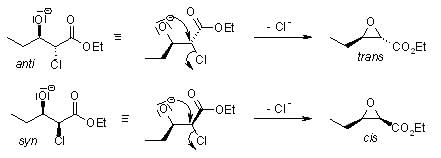Additional Information about Darzens Reaction for Chemistry Preparation
Darzens Reaction Free PDF Download
The Darzens Reaction is an invaluable resource that delves deep into the core of the Chemistry exam.
These study notes are curated by experts and cover all the essential topics and concepts, making your preparation more efficient and effective.
With the help of these notes, you can grasp complex subjects quickly, revise important points easily,
and reinforce your understanding of key concepts. The study notes are presented in a concise and easy-to-understand manner,
allowing you to optimize your learning process. Whether you're looking for best-recommended books, sample papers, study material,
or toppers' notes, this PDF has got you covered. Download the Darzens Reaction now and kickstart your journey towards success in the Chemistry exam.
Importance of Darzens Reaction
The importance of Darzens Reaction cannot be overstated, especially for Chemistry aspirants.
This document holds the key to success in the Chemistry exam.
It offers a detailed understanding of the concept, providing invaluable insights into the topic.
By knowing the concepts well in advance, students can plan their preparation effectively.
Utilize this indispensable guide for a well-rounded preparation and achieve your desired results.
Darzens Reaction Notes
Darzens Reaction Notes offer in-depth insights into the specific topic to help you master it with ease.
This comprehensive document covers all aspects related to Darzens Reaction.
It includes detailed information about the exam syllabus, recommended books, and study materials for a well-rounded preparation.
Practice papers and question papers enable you to assess your progress effectively.
Additionally, the paper analysis provides valuable tips for tackling the exam strategically.
Access to Toppers' notes gives you an edge in understanding complex concepts.
Whether you're a beginner or aiming for advanced proficiency, Darzens Reaction Notes on EduRev are your ultimate resource for success.
Darzens Reaction Chemistry Questions
The "Darzens Reaction Chemistry Questions" guide is a valuable resource for all aspiring students preparing for the
Chemistry exam. It focuses on providing a wide range of practice questions to help students gauge
their understanding of the exam topics. These questions cover the entire syllabus, ensuring comprehensive preparation.
The guide includes previous years' question papers for students to familiarize themselves with the exam's format and difficulty level.
Additionally, it offers subject-specific question banks, allowing students to focus on weak areas and improve their performance.
Study Darzens Reaction on the App
Students of Chemistry can study Darzens Reaction alongwith tests & analysis from the EduRev app,
which will help them while preparing for their exam. Apart from the Darzens Reaction,
students can also utilize the EduRev App for other study materials such as previous year question papers, syllabus, important questions, etc.
The EduRev App will make your learning easier as you can access it from anywhere you want.
The content of Darzens Reaction is prepared as per the latest Chemistry syllabus.
 The Darzens Reaction is the condensation of a carbonyl compound with an α-halo ester in the presence of a base to form an α, β-epoxy ester.
The Darzens Reaction is the condensation of a carbonyl compound with an α-halo ester in the presence of a base to form an α, β-epoxy ester. In the subsequent step, an intramolecular SN2 reaction forms the epoxide:
In the subsequent step, an intramolecular SN2 reaction forms the epoxide: Typically, the cis:trans ratio of the epoxide formation lies between 1:1 and 1:2.
Typically, the cis:trans ratio of the epoxide formation lies between 1:1 and 1:2.
 Darzens methodology for the construction of epoxides can also be used for α-halo carbonyl compounds, or similar compounds that can undergo deprotonation and bear electron-withdrawing groups. In addition, the reaction can be carried out with diazoacetate, where N2 is the leaving group, or with a sulphur ylide with SR2 as the leaving group (see Corey Chaykovsky).
Darzens methodology for the construction of epoxides can also be used for α-halo carbonyl compounds, or similar compounds that can undergo deprotonation and bear electron-withdrawing groups. In addition, the reaction can be carried out with diazoacetate, where N2 is the leaving group, or with a sulphur ylide with SR2 as the leaving group (see Corey Chaykovsky). Another concept for highly diastereoselective and enantioselective transformations was developed by Arai:
Another concept for highly diastereoselective and enantioselective transformations was developed by Arai: In this system, the chiral phase transfer catalyst (PTC) is able to recognize one aldolate selectively. There is an equilibrium between syn- and anti-aldolates via retro-aldol addition, and the formation of a stable, chelated lithium salt blocks the non-catalyzed subsequent reaction from yielding the epoxide product:
In this system, the chiral phase transfer catalyst (PTC) is able to recognize one aldolate selectively. There is an equilibrium between syn- and anti-aldolates via retro-aldol addition, and the formation of a stable, chelated lithium salt blocks the non-catalyzed subsequent reaction from yielding the epoxide product: The following aza-Darzens reaction, in which a preformed lithium α-bromoenolate reacts with a sulphinimine to give an aziridine, features a six-membered transition state that accounts for the high diastereoselectivity:
The following aza-Darzens reaction, in which a preformed lithium α-bromoenolate reacts with a sulphinimine to give an aziridine, features a six-membered transition state that accounts for the high diastereoselectivity: The development of enantioselective methods remains challenging. In principle, any of the methods that are used for stereoselective aldol additions can also be tested in the Darzens Reaction, as the first step is an aldol addition.
The development of enantioselective methods remains challenging. In principle, any of the methods that are used for stereoselective aldol additions can also be tested in the Darzens Reaction, as the first step is an aldol addition.

















